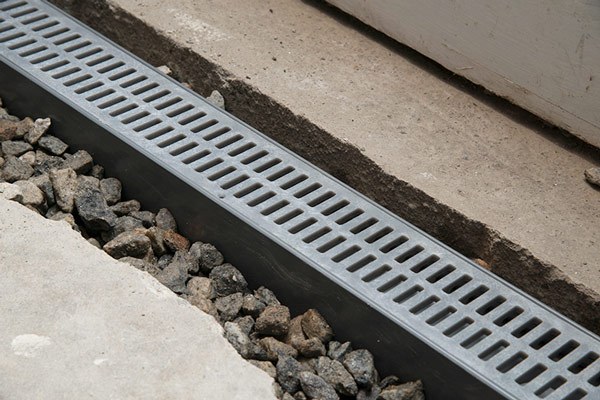I'm installing a trench drain in the dirt right next to the house and I have it in place and most of the way set in concrete. This is to divert water that only goes under the crawlspace door due to the yard basically sloping towards the house in that area. I didn't want to regrade anything.
On the side of the drain facing the crawlspace door, I have concrete all the way up to the surface of the drain since water will only run from the yard side. I have considered adding on a little concrete ledge to that about 1" or so high as sort of a backsplash next to the door in case some water runs across in the slats in the drain grate before going into the drain. But haven't really made up my mind on the ledge yet.
For the yard side, I'm wondering what is usually done for the top of this. Should I just concrete all the way up to the top of the drain on the yard side? Should I leave an inch or two under the top and add in a little gravel or rocks of some type? I saw on one of the shows before (I want to say This Old House or something similar) that they put concrete most of the way up and then stopped short a little from the top, say half of an inch or so. They put in some kind of black tar-like stuff and pounded it flat up to the top of the drain. I think it was some kind of graphite or something. I have even had someone tell me to concrete just about all the way to the top and either set river stones or large crushed gravel into the still-wet concrete so that it basically acts as a barrier for any dirt or debris to not be washed into the drain.
What is done for this step? I've seen pictures of wood chips, but I definitely don't want those around the drain. I have seen some with gravel. Is it best to just concrete up to the top? How do you make the concrete/gravel/whatever near the top of the drain look a little "neater" since it is virtually impossible to dig a perfect looking trench in dirt?
On the side of the drain facing the crawlspace door, I have concrete all the way up to the surface of the drain since water will only run from the yard side. I have considered adding on a little concrete ledge to that about 1" or so high as sort of a backsplash next to the door in case some water runs across in the slats in the drain grate before going into the drain. But haven't really made up my mind on the ledge yet.
For the yard side, I'm wondering what is usually done for the top of this. Should I just concrete all the way up to the top of the drain on the yard side? Should I leave an inch or two under the top and add in a little gravel or rocks of some type? I saw on one of the shows before (I want to say This Old House or something similar) that they put concrete most of the way up and then stopped short a little from the top, say half of an inch or so. They put in some kind of black tar-like stuff and pounded it flat up to the top of the drain. I think it was some kind of graphite or something. I have even had someone tell me to concrete just about all the way to the top and either set river stones or large crushed gravel into the still-wet concrete so that it basically acts as a barrier for any dirt or debris to not be washed into the drain.
What is done for this step? I've seen pictures of wood chips, but I definitely don't want those around the drain. I have seen some with gravel. Is it best to just concrete up to the top? How do you make the concrete/gravel/whatever near the top of the drain look a little "neater" since it is virtually impossible to dig a perfect looking trench in dirt?






